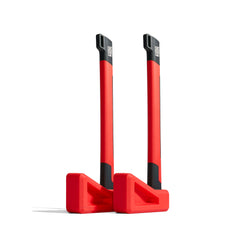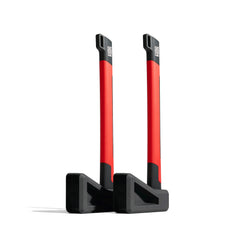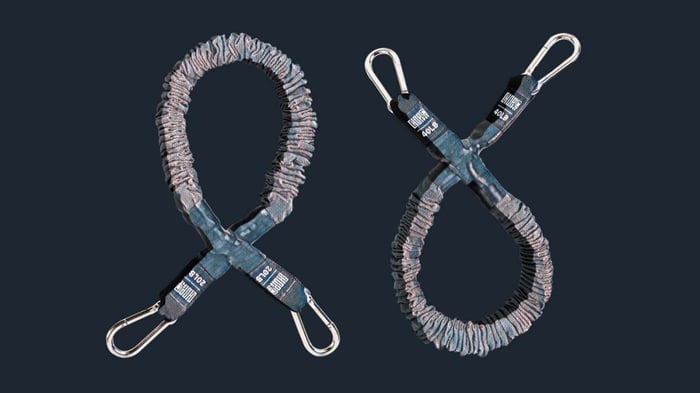Equipment is not always necessary for a heart-pumping workout, but the right equipment can be a great way to build strength and muscle for those who want to elevate their exercise routine.
One of the most affordable and convenient types of minimal equipment are resistance bands. They can be a kick-ass addition to your home workouts and will help you challenge yourself with exercises you already know, such as squats, lunges, leg presses, and arm workouts. In fact, resistance band squats are one of the absolute best movements to work your glutes and tone your butt.
Why Squats?
Squats are the way to go if you want an exercise that targets your glutes and surrounding muscles. Regular squats (without equipment) are a great place to start, but if you reach a point where you are not feeling challenged, a simple way to fix that is to add a resistance band to your squats.
So what are the benefits of doing squats? Aside from working your glutes and many important leg muscles, squats strengthen your lower body, core, and also help to burn calories. They improve flexibility too.
There are many different forms and types of squats to target specific areas of your lower body and keep you from getting burnt out.
And finally, you can literally do squats anywhere.
Benefits of Banded Squats
You'll feel a significant difference in squat movements by incorporating resistance bands into your workouts. Some of the specific benefits you'll get from resistance band squats include:
- Prevent injury with more control over your movements
- Maximize the output of your workout with greater efficiency
- Improve form and range of motion
- Increased focus on glutes, quads and hip abductor muscles

Types of Resistance Bands Squats
There are different types of resistance bands (colors, lengths, sizes, strengths) with the two main variations being loop bands or free bands.
- Loop Bands: Form a complete circle and provide various resistance. Loop bands are versatile and can be used for many types of exercises, but they can be worn above the knees or ankles when it comes to lower body movements.
- Free Bands: Open-ended resistance bands are also extremely versatile and can be looped, wrapped, or anchored to objects for added resistance. They can typically be attached to door frames, doors, poles, etc. Chopper Bands would be considered free bands since they can attach to the Chopper or other stationary objects with the anchor strap.
Once you choose the type of resistance band to use, you can select the types of squats to do. Keep in mind that resistance bands can be added to other exercises and workouts as well for an added challenge.
Here are 5 different types of resistance band squats that can be performed anywhere:
Traditional Banded Squat
- Stand with feet a tad wider than hip-width apart
- Loop the band above your knees
- Slowly push hips back into a sitting position while you are bending your knees until they are at 90 degrees
- Movement should continue until thighs are parallel to the floor
- Hold 2-3 seconds before slowly moving into starting position
Banded Pulse Squat
- Stand with feet a tad wider than hip-width apart
- Loop the band above your knees
- Slowly push hips back into a sitting position while you are bending your knees until they are at 90 degrees
- Movement should continue until thighs are parallel to the floor
- Before you start to rise and return to starting position, slightly rise and pulse (up and down) 3-5 times.
- Slowly rise and return to starting position
Anchored Squat
- Anchor the band around a solid structure (pole, door frame, weighted gym bench, etc.) at 3-4 feet from the floor
- Take the other end of the band and place it around your hips
- Step forward until you feel resistance
- With knees bent slightly, push your hips back (the band will pull the pelvis back when you bend knees)
- Hold 3-5 seconds
- Return to standing position
Banded Sumo Squat
- Stand with feet a tad wider than hip-width apart (toes should be pointed outward around 45 degrees)
- Place loop resistance band just above your knees
- Lower hips back while bending knees into the squat position (knees will follow toe position at 45 degrees)
- Hold and slowly rise to starting position (pushing into heels)
Banded Squat With Lateral Leg Raise
- Start with your feet flat and shoulder-width apart, and slightly turned outward
- Place the resistance band around your lower thighs, just above the knee
- Lower your body into squat position
- As you rise slowly, lift your leg out to the side (straightened without locking knees)
- Slowly bring your leg back to standing position
- Alternate legs
Whether it's with resistance bands or without, squats should be a go to exercise for just about anyone.






